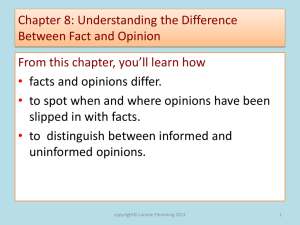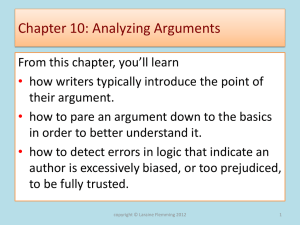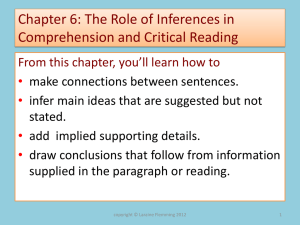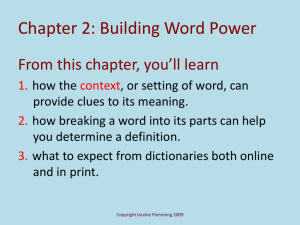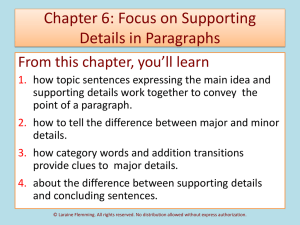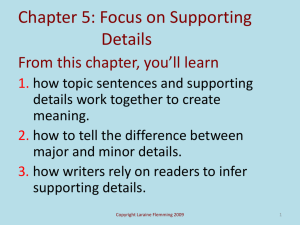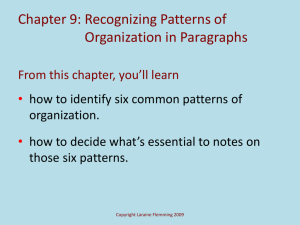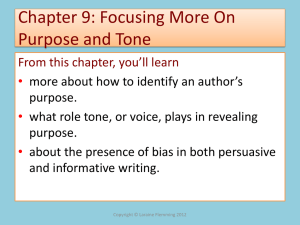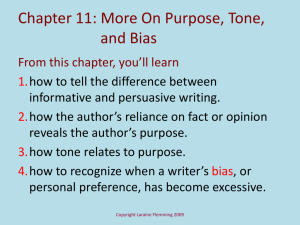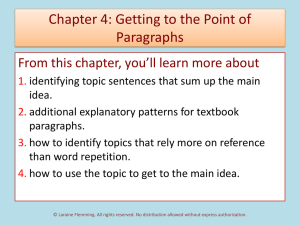Ch. Four - learning lincoln on-line
advertisement
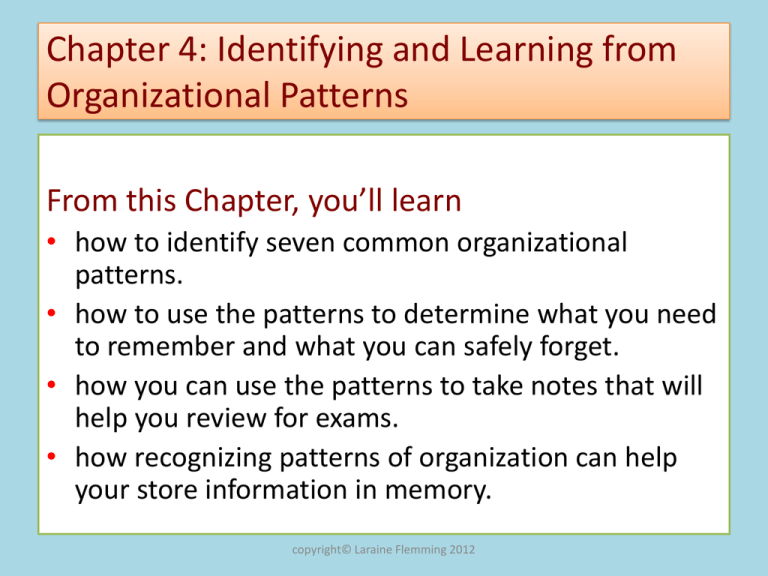
Chapter 4: Identifying and Learning from Organizational Patterns From this Chapter, you’ll learn • how to identify seven common organizational patterns. • how to use the patterns to determine what you need to remember and what you can safely forget. • how you can use the patterns to take notes that will help you review for exams. • how recognizing patterns of organization can help your store information in memory. copyright© Laraine Flemming 2012 Pattern 1: Definition The definition pattern is • one of the most common patterns in textbooks. • one of the easiest patterns to recognize. • frequently combined with other patterns • almost always essential to your notes. copyright© Laraine Flemming 2012 Definition:Key Characteristics • usually opens with the word being defined. • highlights that word in some way, i.e. bold face, annotated, italicized etc. • follows the word being defined with a detailed definition. • can include, in addition to the definition, the word’s history, an example of how it’s used,or a word with which it is commonly confused. copyright© Laraine Flemming 2012 Definition: Example • In marketing, the term cognitive dissonance refers to a buyer’s doubts about a whether a purchase made was the right decision. For instance, after purchasing a new and more expensive cell phone, the buyer may wonder if the added features were worth the additional expense and feel guilty about buying the phone. Cognitive dissonance is most likely to occur when a person has bought an expensive product that lacks some of the desirable features of competing brands. A buyer experiencing cognitive dissonance may attempt to return the product or seek positive information to justify choosing it. (Adapted from Pride and Ferrell. Marketing, p.201) copyright© Laraine Flemming 2012 A Word to the Wise • Like all patterns of organization in writing, the definition pattern does not have a fixed format. The writer can, for instance, delay the definition, telling the reader about other possible definitions before the writer introduces the actual definition he or she has in mind. • The main idea dictates how the organizational pattern is used, not the other way around. Writers may emphasize or downplay different elements of a pattern in order to better explain the main idea. copyright© Laraine Flemming 2012 Definition: Variation • The term unconscious is a notoriously ambiguous word. Some people think it refers to Freudian repressed memories. Others think that it is what happens during a coma, or after being hit on the head, or drinking too much. None of these definitions is what I have in mind. Instead, what I mean by the term is the many things that the brain does that are not available to consciousness. (Adapted from LeDoux, The Synaptic Self, p.11) copyright© Laraine Flemming 2012 Definition: Note-Taking Tips 1. When you take notes on the definition pattern of organization, your focus should be on the definition and perhaps an example of how it’s used. You can pretty much ignore any information concerning what the word doesn’t mean. 2. Definition patterns lend themselves nicely to concept maps, which place the definition in the center of the page. See page 178 of Chapter 4 for an example. copyright© Laraine Flemming 2012 Pattern 2: Process The process pattern is • especially common in business and science textbooks. • the pattern used to explain how something functions or takes place, in other words a process or procedure. • heavily dependent on descriptions of individual steps or stages. • dependent on how the order of events took place in real time. copyright© Laraine Flemming 2012 Process: Key Characteristics • The first or second sentence is likely to announce the process or procedure being explained. • Most of the sentences in the paragraph will introduce a new step or stage in the larger process. • Transitions such as first, second, then, next and finally are often used to highlight each individual step or stage. • The order of the steps or stages reproduces the order in which they occur during real time. copyright© Laraine Flemming 2012 Process: Example According to the writer Elizabeth Kübler Ross, there are five stages in confronting the prospect of death. The first of the five stages is often denial, with the ailing person insisting he or she is fine. Usually short-lived, denial is replaced by anger, with the person facing death feeling unfairly targeted by fate. For those who are religious, the third stage is bargaining with a higher power, and requests are made for just a little more time in order to set things right or see something happen, for instance, “ Let me live until my children are grown.” Depression is, in many cases, the fourth stage. This is the point at which people tell themselves nothing matters because death is so close, why bother caring about anything. If it is achieved, the final stage is acceptance, and the individual decides to accept the reality of death while getting as much as possible out of what’s left from life. copyright© Laraine Flemming 2012 Process: Note-Taking Tips 1. Be sure to identify the larger process being explained. 2. Indicate the number of steps early on in your notes. 3. Make sure the steps follow the order of presentation in the passage. 4. If the passage defines key terms while describing the stages, your notes should define the terms as well. 5. Consider making a flow chart that highlights the individual steps and shows the sequence. See the chapter examples of flow charts on pages 185-186. copyright© Laraine Flemming 2012 Pattern 3: Sequence of Dates and Events The sequence of dates and events pattern • turns up most frequently in history and government texts. • is most likely to explain the individual events that led up to a major cultural change or describe specific events in the development of an idea or a professional career. copyright© Laraine Flemming 2012 Sequence of Dates and Events: Key Characteristics • The topic sentence is likely to introduce a time frame, e.g. “Between 1939 and 1941, Americans watched in horror as Europe was engulfed by a nightmare.” • Dates are presented according to their occurrence in real time and appear in numerous sentences throughout the paragraph • Transitions like “Right before the financial meltdown,” “When the dust settled,” and “Soon after the treaty was signed” frequently open sentences. copyright© Laraine Flemming 2012 Sequence of Dates and Events: Example Born July 18th 1981, champion tennis player Esther Vergeer lost the use of both legs in 1990 when she was nine years old. An operation to relieve a brain hemorrhage had left her permanently paralyzed. But if you think that stopped her ascent to fame and fortune, think again. Vergeer, who had already shown an aptitude for sports went on to play wheelchair basketball and tennis. In wheelchair tennis she became a world champion, winning the United States World Championship in 1998. By 2000, she had won a gold medal in Australia’s paralympics. In 2002 and 2008, she won the Laureus Sportsperson award for person with a disability and is currently considered the most dominant person in her sports. In 2010, she posed naked for ESPN magazine’s annual Body issue, becoming the first person with a disability to appear in the Body issue. copyright© Laraine Flemming 2012 Sequence of Dates and Events :Note-Taking Tips: 1. In listing key dates and events, don’t lose sight of the author’s overall point. Make sure your notes answer the question: What do the dates and events illustrate? 2. Arrange your notes so that the dates line up underneath one another to quickly reveal the time intervals covered in the passage. 3. Consider making a time line like the one shown on page 188 of Chapter 4. copyright© Laraine Flemming 2012 Pattern 4: Simple Listing The simple listing pattern • shows up in almost any type of textbook but is especially popular in science texts. • is used when the order of information is irrelevant to the meaning. • is typically used to identify characteristics, errors, or situations associated with a topic, e.g. “Here are five mistakes you don’t want to make in a job interview,” “There are four good reasons to televise the paralympics. “ copyright© Laraine Flemming 2012 Simple Listing: Key Characteristics • The topic sentences are likely to tell you, for instance, five things you should never do on a first date or four statements you need to include in a professional cover letter. • The supporting details offer specific pieces of information about the topic. • The pieces of information described in the details are all connected by the topic but not necessarily connected to one another. • The order of the information is unimportant; details could be readily switched around without obscuring, or clouding, the point of the passage. copyright© Laraine Flemming 2012 Simple Listing: Example Because employers are making more and more use of social networking sites to screen their employees, job hunters need to keep several pointers in mind. First off, censor your online photographs. Prospective employers are not inclined to hire people who have posted online pictures of themselves chugging beer. (The same goes for sexually revealing pictures). And whatever you do, don’t use the Web to complain about your current job since potential employers will assume you’ll complain about them too if you are displeased with their methods or procedures. Also, make sure that your resumé and your social network page match. If your resumé says you went to Harvard and your Facebook page says the University of Phoenix, your name is likely to be eliminated from an employer’s interview list. Finally, understand and use security settings to maintain your privacy on social networking sites. If you use social networking to keep close friends apprised of your most private thoughts, make sure those thoughts are really limited to your intimate circle. copyright© Laraine Flemming 2012 Simple Listing: Note-Taking Tips 1. The hardest thing about most simple listing passages is remembering the material, because the details have no particular order and often contain information not tightly connected in meaning. Consider making a concept map like the one shown on page 196, so that your brain processes the information in two ways, verbally and visually. 2. Be sure to paraphrase the supporting details. Paraphrasing will etch them more deeply into your long-term memory. 3. Because order is not an important element in simple listing, reverse the original order in your notes. Re-thinking the order will give you another chance to process the information at a deeper level of thinking than just copying the original order allows. copyright© Laraine Flemming 2012 Pattern 5: Classification The Classification Pattern • is heavily used in business and science texts. • describes how some larger group can be divided into a number of smaller, sub-groups. • is typically used in informative writing, where the author wants to explain rather than persuade. copyright© Laraine Flemming 2012 Classification: Key Characteristics • The topic sentence describes how one larger group can be broken down into smaller subgroups. • The topic sentences in this pattern are likely to include words like categories and subgroups. • The topic sentences are also likely to use verbs like broken down into, analyzed, classified, or divided. • Words like categories, groups, and divisions are common to this pattern. copyright© Laraine Flemming 2012 Classification: Example • Bloggers can generally be divided into six different groups. The collaborative blog, for instance, has several different authors and usually a common topic or theme that ties their contributions together. An example of a collaborative blog would be Mashable.com, which focuses on technology and social media issues, all of which are addressed by different contributors. How-To blogs are more likely to be run by one person. They take a good deal of time and effort to maintain because they offer step-bystep tutorials and require real expertise in the procedures explained. Blog-well.com, for example, tries to teach people how to use common programming languages XML and HTML. As their name implies, travel blogs describe great places to visit. The better travel blogs include wonderful pictures along with tips on how to travel to specific locations. Gadling.com would be a good example of this type. Personal blogs express the perspective of a single person on any range of topics, with topics and themes varying widely and often. Krautblog.com would be an excellent example of this category. Food blogs can sometimes fall under the how-to category but not necessarily because a food blog doesn’t always tell you how to cook a specific dish but rather where you can buy or eat wonderful food. Sometimes all you will get is the recipe but no tips on how to go about turning the recipe into your dinner. On Food-e-matters.com, though, you can get all of the previous and more. Political and cultural blogs talk about current issues and offer the blogger’s perspective on those issues. Dailykos.com is an example of a political blog that has become widely known and influential among liberal voters. copyright© Laraine Flemming 2012 Classification: Note-Taking Tips 1. Don’t get nervous if the classification pattern is long. The organization is so predictable, you can usually pull the information out fairly easily. 2. If there is a topic sentence—and there usually is—that identifies the number of categories discussed, paraphrase it and put it at the top of your notes. 3. Don’t forget the number of categories mentioned. That’s an especially important detail. You can use it to check how well you have recorded the major details of the passage. 4. Look for names of the categories and be sure to include them if they are present. Be aware, though, the categories aren’t always identified by name. copyright© Laraine Flemming 2012 Pattern 6: Comparison and Contrast The comparison and contrast pattern • regularly makes an appearance in scientific writing; it’s also common in writing on history. • always addresses two different but somewhat related topics. • can deal with people, events, ideas, even past and present versions of the same place or idea. copyright© Laraine Flemming 2012 Comparison and Contrast: Key Characteristics 1. The topic sentence is likely to announce how two topics differ from or resemble one another; it can also insist that one person, idea, or object is better or worse than another. 2. Comparison and contrast paragraphs often don’t include a stated topic sentence. Instead, the author identifies specific similarities and/or differences and lets them speak for themselves. 3. The author is likely to use transitions such as similarly, in contrast, in the same vein, and however. copyright© Laraine Flemming 2012 Comparison and Contrast: Example • An experiment with dogs suggests that our canine pals, much like ourselves, differ in their attitude toward life: Some dogs are pessimists while others appear to be optimists. In an experiment at a British veterinary school, researchers placed bowls of food in a regular location and got dogs used to finding their dinner there. The researchers then placed a consistently empty bowl in a separate location with a second, food-filled bowl placed between the two. Some dogs, when led to the empty bowl, would just give up if no food was present. These were the pessimists. The optimists, however, having experienced a reward on previous occasions, would keep looking and eventually locate the bowl in the middle. The dogs labeled pessimistic also grew anxious if separated from their owners. They would bark, chew things, and urinate inappropriately. The optimistic dogs, however, tended to fall asleep when left alone. They also greeted strangers as possible substitute playmates. In contrast, the pessimistic dogs would react to strangers with fear and aggression. copyright© Laraine Flemming 2012 Comparison and Contrast: Note-Taking Tips 1. Don’t get so caught up in the similarities and differences described that you leave out the main idea they develop. Writers use similarities and differences to make a point. Make sure your notes do the same. 2. Even if you don’t think of yourself as a visual learner, consider making a diagram like the one shown on page 206 of Chapter 4. Diagrams can give your mind two ways to remember the similarities and differences, the words themselves and the visual image of how they look in a diagram. Doubling up the way your brain records new information is a superb way of making sure that the material you are learning stays with you for a very long time. copyright© Laraine Flemming 2012 Pattern 7: Cause and Effect The cause and effect pattern • appears frequently in just about every kind of writing. • explains how one event led to or produced another. • can focus on causes and/or effects. • often describes a chain reaction with an effect becoming the cause of new and different consequences. copyright© Laraine Flemming 2012 Cause and Effect: Key Characteristics 1. The topic sentence explains how one event (the cause) led to or produced another event (the effect). 2. Verbs such as produces, generates, induces, causes and instigates are common. 3. The writer relies heavily on transition like as a result, consequently, in response to, and therefore 4. Connectives* like because, as, due to, and since are common in this pattern. *Connectives are words that link together parts of sentences. They are also called conjunctions. copyright© Laraine Flemming 2012 Cause and Effect: Example Bats in the Northeast are dying in catastrophic numbers. Biologists estimate that only 10 percent of the region’s cave-dwelling bats are still alive. The cause of the bats’ death seems to be a powdery white fungal infection called “White Nose Syndrome, “ because bats suffering from the disease look as if their noses were covered by a thin layer of white gauze. A number of proposals are being circulated to prevent the disease from spreading, and all of them have high price tags. But most states in the Northeast are taking the threat seriously and are willing to spend the money in order to prevent more bats from dying. Vermont, for instance, announced a 1.9 appropriation to study the prevention of White Nose Syndrome, which may not be what actually kills the bats but which seems to weaken them to such a degree that they can no longer hunt and die of starvation. Those who think saving bats is not an important enough issue to spend huge sums of money on need to think again. Bats kills insects. Without them, crops are likely to suffer serious infestations of destructive bugs. Mosquitoes and mosquito-borne illnesses could also prove a serious problem if bats continue to die in huge numbers. copyright© Laraine Flemming 2012 Note-Taking Tips 1. Make sure you accurately paraphrase the cause and effect relationship described in the topic sentence. 2. Use arrows or even arrows and boxes to indicate a chain of causes and effects, like the one shown on page 211. 3. Make your notes reflect the proportions of the paragraph. If the author’s emphasis is on causes more than effects, your notes should show the same emphasis or balance. copyright© Laraine Flemming 2012 A Word to the Wise •Writers frequently combine patterns of organization to make their point. Depending on the main idea, the patterns might be equal in importance or one pattern might be primary, or more significant than the other pattern or patterns. •For instance, this sentence, would seem to require just one pattern, sequence of dates and events: “Russia’s Prime Minister, Vladimir Putin, has had a long and somewhat sinister career.” But what about this sentence: “Our brain requires that a number of specific steps be completed in order to remember new information for more than a few minutes”? copyright© Laraine Flemming 2012 Final Wrap: Identifying and Learning from Organizational Patterns Read each list of characteristics and decide which pattern the list fits. 1. These characteristics are typical of the ___________pattern. a. The topic sentence explains how something functions, happens, or develops. b. Transitions like first, second, next, and finally often mark different steps or stages. c. The order of the supporting details is crucial. 2. These characteristics are typical of the ____________ pattern. a. The similarities and/or differences between two topics are discussed in detail. b. The transitions used are likely to be words or phrases such as in contrast, whereas, and similarly. c. The main idea is very likely to be implied rather than stated. copyright© Laraine Flemming 2012 Final Wrap: Identifying and Learning from Organizational Patterns 3. These characteristics are typical of the ___________pattern. a. The topic sentence introduces a key word or phrase that is followed by a definition. b. Often the key word or phrase is in italics or boldface. c. The remainder of the paragraph might provide some history. 4. These characteristics are typical of the ___________ pattern. a. There’s likely to be transitions such as by 1972, after the fall of 1941. b. The pattern is likely to be accompanied by timelines and flow charts c. The order in which events are presented is critical to the meaning. copyright© Laraine Flemming 2012 Final Wrap: Identifying and Learning from Organizational Patterns 5. These characteristics are typical of the _________ pattern. a. The main idea describes how some larger group can be sub-divided into smaller sub-groups. b. The author names a number of categories. c. The author specifically describes different categories belonging to the larger group. 6. These characteristics are typical of the _________ pattern. a. The topic sentence includes words such as symptoms, risks, and characteristics. b. The order of the supporting details can be completely reversed without causing confusion. c. The supporting details are related to the topic but not necessarily to one another. copyright© Laraine Flemming 2012 Final Wrap: Identifying and Learning from Organizational Patterns 7. These characteristics are typical of the ____________ pattern. a. The topic sentence explains how one event produced or caused another. b. The author uses transitions such as as a result, in consequence of that action, and in response to. c. The author uses verbs like stimulates, causes, produces, and triggers. 8. What pattern (or patterns) would you expect to see used in a passage that begins like this: “In the Netherlands, between 1904 and 1940, 12 different bills banned various categories of married women from paid work”? copyright© Laraine Flemming 2012 Final Wrap: Identifying and Learning from Organizational Patterns 9. What pattern or patterns would you expect to see used in a passage that begins like this: “Scientists are concerned by evidence that wild bumble bees may be following in the footsteps of domestic honey bees, which are disappearing in huge numbers”? 10. What pattern or patterns would you expect to see used in a passage that begins like this: “Many media pundits have claimed that the war in Afghanistan will mirror the war in Viet Nam, but in fact, the two wars are very different in nature”? copyright© Laraine Flemming 2012
